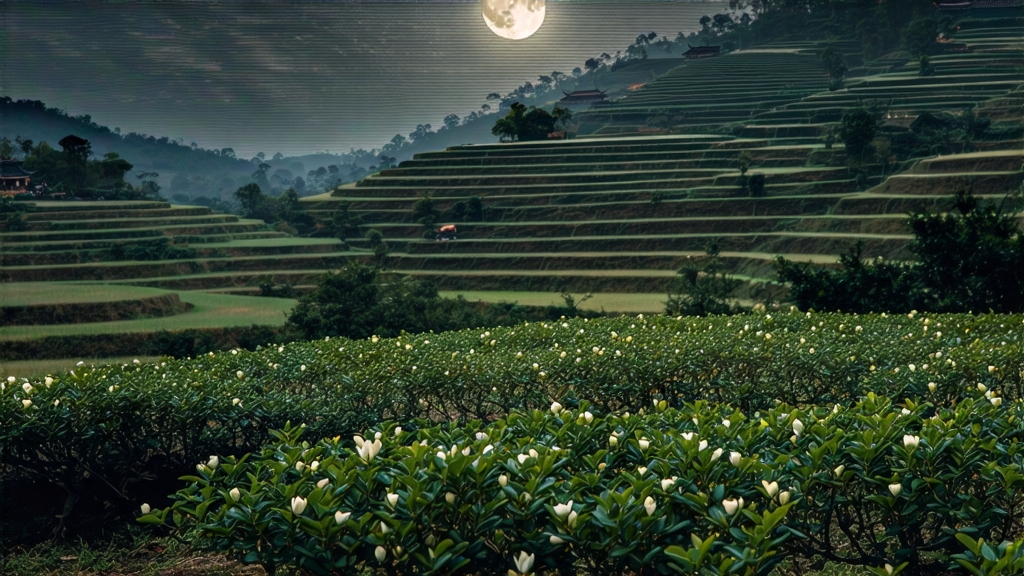
Tucked high in the cool foothills of southern Yunnan, where the Mekong bends like liquid jade and the air smells of pine and wild orchid, a tea is born in secrecy while the province sleeps. Locals call it Yue Guang Bai—Moonlight White—because, legend claims, the leaves are allowed to “breathe” only under the moon, never the sun. Romantic as that sounds, the practice is rooted in pragmatic genius: night withering slows oxidation, preserves delicate aromatics, and gifts the cup a mellow, almost milky sweetness impossible to replicate under harsh daylight.
Although white tea as a category was first documented in Fujian during the Song dynasty (960-1279), Yue Guang Bai is a relative newcomer, appearing only in the late 1990s when Yunnan growers, armed with centuries of pu-erh expertise, began experimenting with their indigenous Da Ye (Big Leaf) cultivar. They borrowed the minimalist ideology of Fujianese white tea—pick, wither, dry—but replaced the coastal sea mist with the plateau’s crisp mountain air and starlight. The result was a hybrid that carries Yunnan’s wild soul in a white tea’s feather-weight frame.
The cultivar itself is critical. Camellia sinensis var. assamica, famous for powering ripe pu-erh, is usually associated with heft and darkness. Yet when picked early, before Qingming, the buds are downy silver and the first leaf barely unfurls, yielding a concentration of amino acids rarely found in assamica. These spring tips are the sole material for authentic Yue Guang Bai; anything plucked later becomes a different tea altogether.
Crafting Moonlight White is a race against dawn. Picking begins at twilight, around 7 p.m., when residual warmth leaves the leaf but before dew forms. Wicker baskets, lined with mosquito netting to prevent compression, are carried to open-air withering lofts built under retractable bamboo roofs. Here the leaves rest on raised mesh trays while night breezes—cool, slow, humid—coax moisture away at a glacial pace. Unlike Fujian’s Bai Hao Yin Zhen, which is sun-withered for a single morning, Yue Guang Bai may spend three consecutive nights in partial moonlight, shielded by day under gauze canopies. This nocturnal rhythm, repeated for 48–60 hours, oxidizes the leaf edges a charcoal black while the center remains pale jade, creating the signature “one side dark, one side light” appearance that poets liken to a lunar eclipse.
Once moisture drops to roughly thirty percent, the leaves are transferred to low-temperature charcoal ovens for a final twenty-minute bake. Temperature cannot exceed 45 °C; any hotter will seal the leaf too quickly, trapping grassy notes that clash with the desired honeyed profile. The finished tea is not bone-dry like green tea—about eight percent residual humidity is left so that slow, post-production maturation can continue, much like raw pu-erh. Indeed, well-stored Yue Guang Bai can evolve for a decade, trading floral top notes for deeper dried apricot and sandalwood.
Classification within the white tea family is still debated. Because the leaf is larger and oxidation slightly higher than Fujian’s silver needle, some argue it belongs in a “light oolong” niche. Yet Chinese customs categorizes it as white tea, and the processing intent—minimal intervention, no rolling, no fixing—aligns philosophically with white tea doctrine.
To brew Moonlight White respectfully, think of it as a shy guest who reveals secrets only in quiet rooms. A 150 ml porcelain gaiwan is ideal; glass dissipates heat too quickly, while zisha clay can bully the subtle aromatics. Use 4 g of leaf—about two heaping tablespoons—rinsed briefly with 85 °C water to awaken the buds. Discard the rinse; it carries stray down and field dust. First infusion: 30 seconds at 88 °C. The liquor emerges the color of pale chardonnay, almost water-clear against white porcelain. Bring the cup to your nose before sipping; top notes are night-blooming jasmine and fresh lychee, underpinned by a cool mountain minerality. On the palate the texture is glycerin-smooth, a silken coat that lingers without astringency.
Subsequent infusions can be stepped: 45, 60, 90 seconds, then two minutes, each time nudging the temperature up one degree. By the fifth steep the leaf